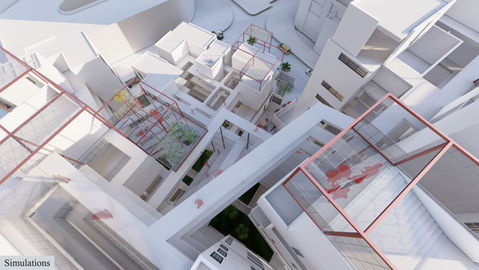Create Your First Project
Start adding your projects to your portfolio. Click on "Manage Projects" to get started
Housing
A residential project consisting of 120 housing units over an area of 4,000 dunams in the Sde Dov area, Tel Aviv.
The project explores the concept of family and the socially cohesive community that exists within traditional villages, and extends this idea toward the modern city—diverse and complex yet socially fragmented—to propose a civil, socially connected urban society.
It aims to create a strong and safe environment inspired by the living room and courtyard of the rural house, which serve as central spaces for family gatherings and for strengthening social ties.
In many urban residential buildings, common spaces are barely used by the residents; they often exist only as small seating areas near entrances or inactive front/back yards.
Therefore, this project seeks to allow the city to absorb the values of the rural home—learning from its safe, supportive, and emotionally rich spatial logic—and to reinterpret them within the emotionally neutral urban environment.
The ground floor includes commercial areas, cafés, educational and study spaces, and open green courtyards accessible to all, not just to the building’s residents.
Apartment Types
The building features a diversity of apartment types accommodating various family structures (five in total):
• A – Apartment for a single resident
• B – Apartment for a couple
• C – Apartment for a family with one child
• D – Apartment for a family with 2–3 children
• E – Duplex apartment for large families with 4–5 children
The arrangement of the apartments promotes healthy neighborly relations:
A may border A or B;
B may border A, B, or C;
C may border B, C, or D;
D may border C, D, or E;
E may border D or E.
The internal layout moves from private to semi-public: all areas are private except for the inner courtyard, which sometimes faces a neighboring courtyard to encourage visual connection.
A large integrated storage wall runs through the apartment, functioning both as storage and as part of the circulation route, maximizing the use of interior space.
Shared Spaces
The main structural element of the building also serves a dual function: to generate shared spaces.
These appear within residential floors, connect different levels, and extend up to the roof—creating interaction between residents from different floors.
The result resembles small living rooms within the large structure, echoing the intimacy of a family living room, turning the entire building into one big family.
Green Space
The green area is designed inside the building rather than in front or behind it.
It forms the largest communal space, accommodating a large number of residents.
Its plants and trees are reminiscent of those in rural courtyards, evoking the emotional sense of “home” and unity despite individual differences.
Circulation System
Finally, all of these social connections are reinforced through a clear and connective circulation system linking the various floors, ensuring both movement and social continuity throughout the building.





















